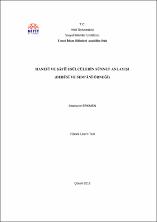| dc.description.abstract | The topic (main idea) of the thesis is understanding of Sunna between Hanefî and Shafi jurists. The example of (case) of Debûsî and Semani. In our thesis, we talk about concept of Sunnah and the source of it and after that we will inform you about understanding the sunnah of the jurists of Hanefî Debûsî and the jurists of Shafi Semani. Lastly, The contradiction and the critism of Semani against Debûsî. Our thesis consists of an Entry and two sections (parts). At the Entry part, it is about the signifacance, the boundries and the presentation of it. In the first part; we will give information about the biography of Debûsî and Semai, their works, achievements and the history of their life time. History during their time. again in the continuation of the first part, we will inform you about the concept of sunnah and the source of Sunnah. The second part of our thesis is the most important part of it. Ġn the second part of our theis, the main part of thesis, we examined or worked detailly of understanding the sunnah of the jurists of Hanefî and the jurists of Shafi (The Cases Of Debûsî And Semânî). Ġn this section, the Hanefî‟s understanding of sunnah before (in advance of time, earlier) Debûsî, the Sunnah understanding of Debûsî, the Shafi‟s understanding of Sunnah before Semani. We worked on the Semani‟s Sunnah understading and then we based on “Kavatiul Edille” which we got info‟s about Semani‟s critism against Debûsî. Thus, we attpempt to identify the differences between the Shafi'i and Hanafi Sunnah understanding and their left points. In this study, we dwelled on three methods.
1. The concept of Sunnah and the source fort the ıslamıc studıes
2. The understanding of Sunna between Debûsî and Semani were determined
3. From the cases of Debûsî and Semani, the differences, left points, and the causes were determined. | en_US |
| dc.description.tableofcontents | İÇİNDEKİLER -- ÖZET ,i -- ABSTRACT ,ii -- İÇİNDEKİLER ,iv -- KISALTMALAR ,vii -- ÖNSÖZ ,viii -- GİRİŞ ,1 -- 1. KONUNUN ÖNEMİ ,1 -- 2. KONUNUN SINIRLANDIRILMASI VE SUNUMU ,2 -- BİRİNCİ BÖLÜM -- TARİHSEL VE TEORİK ARKA PLAN -- 1. DEBÛSÎ’NİN HAYATI, İLMÎ KİŞİLİĞİ VE ESERLERİ ,5 -- 1.1 Tarihî Arka Plan ,5 -- 1.2 Hayatı ,8 -- 1.3 İlmî Kişiliği ve Eserleri ,9 -- 1.3.1 Hadîs ,12 -- 1.3.2 Fıkıh ,12 -- 1.3.3 Kelam ,16 -- 1.3.4 Tasavvuf ,17 -- 1.3.5 Hocaları ve Öğrencileri ,17 -- 1.3.5.1 Hocaları ,17 -- 1.3.5.2 Öğrencileri ,17 -- 2. SEM’ÂNİ’NİN HAYATI, İLMÎ KİŞİLİĞİ VE ESERLERİ ,19 -- 2.1 Tarihî Arka Plan ,19 -- 2.2 Hayatı ,24 -- 2.3 İlmî Kişiliği ve Eserleri ,30 -- 2.3.1 Tefsir ,31 -- 2.3.2 Hadîs ,32 -- 2.3.3 Fıkıh ,35 -- 2.3.4 Kelâm ,36 -- 2.3.5 Sem’ânî’nin Hocaları ve Öğrencileri ,37 -- 2.3.5.1 Hocaları ,37 -- 2.3.5.2 Öğrencileri ,38 -- 3. SÜNNET KAVRAMI, SÜNNETİN KAYNAK DEĞERİ,39 -- 3.1 Sünnet Kavramı ,39 -- 3.1.1 Muhaddislere Göre Sünnet ,40 -- 3.1.2 Fakîhlere Göre Sünnet ,41 -- 3.1.3 Usûlcülere Göre Sünnet ,42 -- 3.1.4 Kelamcılara Göre Sünnet ,42 -- 3.2 Sünnetin Teşrideki Yeri Ve Kaynak Değeri ,42 -- İKİNCİ BÖLÜM -- HANEFÎ VE ŞÂFİÎ USÛLCÜLERİN SÜNNET ANLAYIİI (DEBÛSİ VE SEM’ÂNÎ ÖRNEĞİ) -- 1. DEBÛSÎ VE SEM’ÂNÎ ÖNCESİ HANEFÎ VE İÂFİÎLERDE SÜNNET ANLAYIŞI ,45 -- 1.1 Debûsî Öncesi Hanefîler’de Sünnet Anlayışı ,45 -- 1.1.1 Debûsî Öncesi Hanefîlerin Haber Taksimleri ,48 -- 1.1.1.1 İlk Dönem Müçtehitlere Göre Haberin Tanım, Taksim ve Bilgi Değeri ,48 -- 1.1.1.2 Îsâ bin Ebân ve Cessâs’a Göre Haberin Tanım, Taksim ve Bilgi Değeri ,51 -- 1.1.2 Debûsî Öncesi Hanefîlerin Usûlünde Sünnetin Teşri‟ Kaynağı Olarak Kullanılması ,58 -- 1.1.2.1 Mütevâtir ve Meşhur Haber‟in Teşri Kaynağı Olmaları ,58 -- 1.1.2.2 Haber-i Vâhid ve Teşri Kaynağı Olması ,60 -- 1.1.2.3 Değerlendirme ,73 -- 1.2 Sem‟ânî Öncesi İâfiîler‟de Sünnet Anlayışı ,75 -- 1.2.1 İmam-ı İâfiî‟nin Sünnet Anlayışı ,76 -- 1.2.1.1 Haber-i Âmme (Mütevâtir Haber) ,81 -- 1.2.1.2 Haber-i Hâssâ (Haber-i vâhid) ,82 -- 1.2.2 Ebû İshak eş-Şîrâzî (393/1003-476/1083) ve İmâmü‟l-harameyn el-Cüveynî‟nin (419/ 1028-478/ 1085) Sünnet Anlayışları ,93 -- 1.2.2.1 Mütevâtir Haber ,93 -- 1.2.2.2 Haber-i Vâhid ,94 -- 2. DEBÛSÎ VE SEM’ÂNÎ’NİN SÜNNET ANLAYIŞLARI ,108 -- 2.1 Debûsi‟nin Sünnet Anlayışı ,108 -- 2.1.1 Mütevâtir Haber ,111 -- 2.1.2 Meşhur Haber ,112 -- 2.1.3 Âhâd Haber ,114 -- 2.1.3.1 Haber-i Vâhid‟in Hücciyyeti ,114 -- 2.1.3.2 Haber-i Vâhidin Hüccet Olduğu Hususlar ,122 -- 2.1.3.3 Râvînin Şartları ,123 -- 2.1.3.4 Haber-i Vâhid‟in Mana ile Rivayeti ,126 -- 2.1.3.5 Haber-i Vâhidin Kabulü İçin Öngörülen Kriterler,127 -- 2.1.3.6 Haber-i Vâhid ve Fakîh Râvî Meselesi ,138 -- 2.2 Sem‟ânî‟nin Sünnet Anlayışı ,142 -- 2.2.1 Mütevâtir Haber,143 -- 2.2.2 Âhâd Haber ,145 -- 2.2.2.1 Haber-i Vâhidin İlim İfade Edebildiği Yerler ,145 -- 2.2.2.2 Haber-i Vâhid‟in Amel Gerektirdiği Yerler ,147 -- 2.2.2.3 Haber-i Vâhidin Hüccet Alanı ,154 -- 2.2.2.4 Râvînin Şartları ,155 -- 2.2.2.5 Haberin Mana ile Rivayeti ,157 -- 3. SEM’ÂNÎ’NİN DEBÛSÎ’YE ELEŞTİRİLERİ ,158 -- 3.1 Takvimü‟l-edille‟ye Karşı Kavatıu‟l-edille ,158 -- 3.2 Sünnetin, Kur‟an‟a Arzı ,159 -- 3.3 Haber-i Vâhid ve Umûmu‟l-belvâ ,164 -- 3.4 Mütevâtir ve MeĢhur Haber Ayırımı ,168 -- 3.5 Kitab‟ın, Sünnet ile Tahsîsi ,168 -- 3.6 Râvîlerin Fâkihliği ve Kıyasa Aykırılık ,173 -- 3.7 Râvînin Rivayetini İnkâr Etmesi veya Hilafına Amelde Bulunması ,176 -- 3.8 Mürsel Haberler ,177 -- SONUÇ ,179 -- KAYNAKÇA ,183 -- | en_US |


















